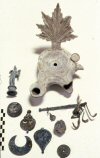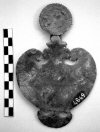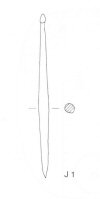To best understand the role of artefacts in informing on social behaviour, one needs a good understanding of artefact function. Broadly speaking, much information on artefact function has been based on relatively anecdotal approaches to excavated Roman remains (see Allison 1999a; 2001, esp. 195-97).
The sites where artefacts and their contexts can be best used to inform on artefact functions are those at which the site formation processes have caused the least alteration to supposed normal living conditions at that site (see Schiffer 1987), and thus artefact assemblages are likely to be found in the context of their end use. The most suitable sites are those which are either short-lived, rapidly abandoned, or both. Although their depositional processes often do involve a whole range of discard processes (see e.g. Clarke 1994; Gardner 1999, 408; Baker 2001, 57-58), Roman military sites can be among some of the best types of site to fulfil these criteria. They are often short-lived, which means there is less chance than at most settlement sites of the reuse of spaces for different activities, and less chance of extensive redeposition, particularly of lost items. They are also frequently rapidly abandoned so there is a greater chance that artefact assemblages have been left at the location of their end use. Sometimes they are both short-lived and rapidly abandoned, in which case there is an even higher chance that the recorded artefact assemblages document the living conditions at that site. Also, because of the supposed single function of military sites, there is less likely to be a change of use for the various components of those forts that do not grow into civilian centres.
The Roman site where rapid abandonment is most apparent is the town of Pompeii. This site has often been viewed as an eponymous site, providing the 'nearest thing to a time capsule' (Jongmann 1988, 55), that can be used as a yardstick against which to measure less well-preserved sites (Schiffer 1985). Thus, Pompeii ostensibly offers an ideal site for using artefact distribution to inform on social behaviour in the Roman world, particularly the use of domestic space. While Pompeian scholars are only too aware that the site does not offer the pristine conditions assumed by the New Archaeologists (compare Binford 1981 and Schiffer 1985 with Zanker 1988, 41; see also Allison 1992; Wallace-Hadrill 1994, 87-89; Fröhlich and Jacobelli 1995), it still provides an archaeological record which is unparalleled in terms of relationships between artefact distribution and spatial behaviour.
In addition, the actual study of social behaviour and the use of space at Pompeii is comparable to that of Roman military sites. The structuralist approach that scholars like von Petrikovits (1975) have taken to Roman military installations (see Section 2.1.3) has long been the approach used to identify the use of space in Roman houses (e.g. Becker 1876; Mau 1899; McKay 1977; Wallace-Hadrill 1994; cf. Leach 1997).
For the last seventeen years I have been studying artefact distribution in Pompeian domestic contexts, both to test the structural approach to room use and to reinvestigate the abandonment processes at this site (Allison esp. 1994; 2004). This study has included the compilation and analyses of databases of some 16,000 artefacts from thirty Pompeian houses (http://www.stoa.org/projects/ph/home). This database has been analysed, in combination with an assessment of household assemblages and a critical approach to the use of ancient written sources, to produce more informed perspectives to the use of Roman domestic space. This research has also involved detailed analyses of Roman artefacts and artefact assemblages with similarly critical approaches to their Latin nomenclature and its use in the written sources (e.g. Allison 1999a). I have also been concerned with archaeological approaches to the social category 'household', and to use the physical remains of houses and their contents for information on the people who occupied these spaces (Allison 1999b, 2001).

Figure 7: Pendants and other objects (inv nos 4907-10) from a box in room 35, Casa del Menandro in Pompeii (photo P. M. Allison)
My interest in artefact assemblages and artefact distribution led to my joining the British Pompeii Research Committee's project on the Insula del Menandro in Pompeii (Ling 1997; Painter 2001; http://www.stoa.org/projects/ph/home; the Casa del Menandro, the Casa del Fabbro, House I 10, 8, the Casa degli Amanti). This British project, commenced in the mid 1970s, is a reinvestigation of Amedeo Maiuri's 1930s excavation and publication of this insula (Maiuri 1933). My contribution comprises a catalogue and analyses of the excavated house contents from the insula, organised according to provenance, rather than typologically, and studied according to context and function (Allison n.d. 1) (Figure 7).
My Pompeian research has been concerned with the analysis of material from excavations carried out, in some instances, over 200 years ago. Thus, they have involved detailed investigations of the Pompeian excavation archives (See Section 5). Like many excavated Roman military sites, these excavations by no means provide perfect data from which to extract information on social behaviour but, given the considerable amount of data available, it was possible to produce meaningful information.

Figure 8: Pendant (inv. no. 4869) as part of harness from courtyard 34, Casa del Menandro in Pompeii (photo J. Agee)
This research has, therefore, included much detail on Roman artefacts which have received little press in the archaeology of Roman Italy, particularly the archaeology of Pompeii. My concentration on the functional aspects of these artefacts is also an approach that has tended to be employed only summarily in this region (cf. Carandini 1984; Berry 1997). For these reasons, to find comparable material with comprehensive publication, I found myself constantly turning to artefacts excavated in the Roman provinces, particularly in the western provinces and especially in Britain, Holland and Germany, (e.g. Ulbert 1969; Crummy 1983; Manning 1985). I also began to recognise the similarities with, and the differences between, the artefact assemblages from the 1st century CE urban site of Pompeii and the largely military sites of similar date in the western provinces or, more particularly, the similarities and differences between the functions ascribed by modern scholars to the artefacts from the different realms. Artefacts often considered to have a military function were turning up in Pompeian houses. For example, a horse pendant (Figure 8) found in the Casa del Menandro in Pompeii is of a type commonly identified as cavalry equipment (see Bishop 1988, esp. fig. 44.3c). Conversely, artefacts considered for female adornment or for female industries in Pompeian houses and other urban contexts were sometimes ascribed other functions, or passed over, when unearthed within Roman military sites (compare Crummy 1983, 19-25 with Hanel 1995, 285 and cat. no. J1, classified as a stylus - Figure 9). So, I decided that it would be interesting to apply the same approaches and principles that I had applied to Pompeian houses to these military sites.

Figure 9: Vetera bone stylus J1 (Hanel 1995, pl. 165)
© Internet Archaeology
URL: http://intarch.ac.uk/journal/issue17/4/3.1.html
Last updated: Mon Apr 4 2005